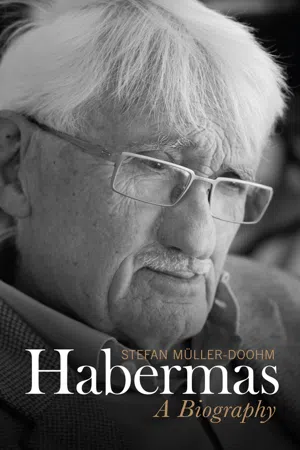
- English
- ePUB (mobile friendly)
- Available on iOS & Android
About This Book
'Jürgen Habermas', wrote the American philosopher Ronald Dworkin on the occasion of the great European thinker's eightieth birthday, 'is not only the world's most famous living philosopher. Even his fame is famous.' Now, after many years of intensive research and in-depth conversations with contemporaries, colleagues and Habermas himself, Stefan Müller-Doohm presents the first comprehensive biography of one of the most important public intellectuals of our time. From his political and philosophical awakening in West Germany to the formative relationships with Adorno and Horkheimer, Müller-Doohm masterfully traces the major forces that shaped Habermas's intellectual development. He shows how Habermas's life and work were conditioned by the possibilities offered to his generation in the unique circumstances of regained freedom that characterized postwar Germany. And yet Habermas's career is fascinating precisely because it amounts to more than a corpus of scholarly work, however original and influential that may be. For here is someone who continually left the protective space of the university in order to assume the role of a participant in controversial public debates Ð from the significance of the Holocaust to the future of Europe Ð and in this way sought to influence the development of social and political life in an arena much broader than the academy. The significance and virtuosity of Habermas's many writings over the years are also fully and expertly documented, ranging from his early work on the public sphere to his more recent writings on communicative action, cosmopolitanism and the postnational condition. What emerges from this biography is a vivid portrait of one of the great public intellectuals of our time Ð a unique thinker who has made an immense and lasting philosophical contribution but who, when he perceives that society is not living up to its potential for creating free and just conditions for all, becomes one of its most rigorous and persistent critics.
Frequently asked questions
Information
PART I
Catastrophe and Emancipation
The moment of catastrophe is also the moment of emancipation.1
1
Disaster Years as Normality: Childhood and Youth in Gummersbach
Our life-form is connected to the life-form of our parents and grandparents through a mesh of familial, geographical, political, and also intellectual traditions which is difficult to disentangle – through an historical atmosphere, that is, which made us what and who we are today.1
Thus, for instance, monarchists fought against republicans, conservatives against liberals and social democrats, völkisch nationalists against proponents of a state based on citizenship [Staatsbürgergesellschaft], anti-Semites against the advocates of a continuing social integration of Jewish Germans, those who glorified war against those who were sceptical towards war, mystagogues of the Reich against political realists, those who defended the thesis of a German ‘Sonderweg’* against self-critical pragmatists, religious socialists against orthodox Lutherans, prophetic dreamers against supporters of routine politics, geopolitical dogmatists against clear-headed representatives of particular interests, those who sympathized with Italian fascism against the defenders of the republic, advocates of the total state against liberal democrats – it was a true witches’ cauldron of political theories and phobias in which very categorical and often fundamentalist oppositions always set the tone.2
The route to the Gries butcher’s shop passed the Gasthof Winter, the Café Garnefeld and the Wetzlars’ house; and, on the way to my piano lessons in Winterbecke, I saw the Hotel Koester and the old Magistrate’s Court once a week. … From my youth I remember more strongly the electric tramway …, the indoor swimming pool, the town hall, the Schützenburg, the community hall, and Schramm’s toy shop.4
Table of contents
- Cover
- Title Page
- Copyright
- Preface
- Acknowledgements
- Illustration Acknowledgements
- Prologue: The Other among his Peers
- PART I CATASTROPHE AND EMANCIPATION
- PART II POLITICS AND CRITIQUE
- PART III SCIENCE AND COMMITMENT
- PART IV COSMOPOLITAN SOCIETY AND JUSTICE
- Epilogue: The Inner Compass
- Genealogy
- Chronology
- List of Habermas’s Lectures and Seminars
- Visiting Professorships
- List of Archives
- Bibliography of Works by Jürgen Habermas
- Secondary Literature
- Index
- End User License Agreement